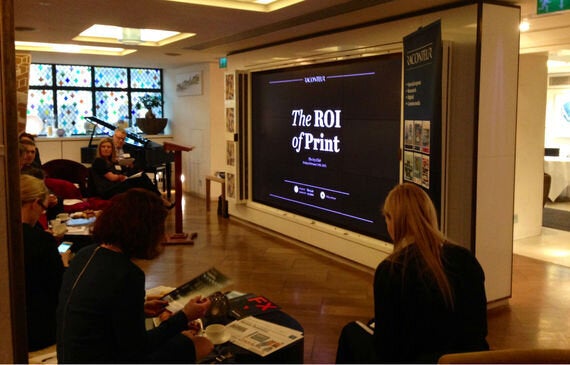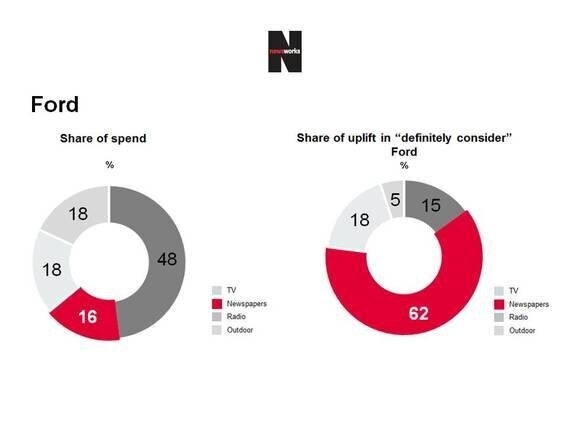
(Image: Raconteur)
It seems we've reached the tipping point. The global sale of ebooks has levelled off and is looking to decline. Major trade press publications that went online-only are back in print after uproar from their readerships, demanding the commitment of print over the "take-it-or-leave-it" of online content. But despite strong evidence of a print renaissance coupled with logic that says that if the digital world is now overcrowded, then print offers a renewed opportunity for brands, even some the best marketers are still loathe to spend money on print.
Last Friday, Raconteur hosted an invite-only breakfast event at The Ivy Club on the ROI of Print for high-level marketers to pick apart this phenomenon and better advocate for print internally. With keynote speakers Ray Snoddy, former BBC commentator and Financial Times journalist, and Vanessa Clifford, Deputy Chief Exec of newsbrand body Newsworks, and our Head of Publishing, Will Brookes, we endeavoured to address one of the biggest questions plaguing the marketing industry today - is print still a great medium - and if so, how do we prove its ROI?
The first question we asked the audience was a show of hands: How many of you feel pressured to quantify your 'ROI' from marketing? All hands went up. Vanessa pointed out that the major roadblock is how we're defining 'ROI' in the first place. Often when we talk about ROI, we're just measuring clicks, not outcomes. But when you think about business goals, the valuable metrics are trust, brand stature, education, understanding, and prompting action - and it's only on the last one that looking at clicks is even an appropriate measure. But marketing must do ALL of these things. As Einstein noted, "not everything that counts can be counted, and not everything that can be counted counts". But marketers are trying too hard to force the 'counting' - how many print ads do we see with QR Codes or long URLs? Almost 100% of them. And how many of us, as consumers, act on that? Not one. So why can't marketers see the parallels between their job and the anthropology of what people do or don't do? The behaviour this perpetuates is counter-productive: marketers stick a QR code on a print ad to track 'ROI', no one scans it, and then marketers have to deduce that print isn't worthwhile. But the evaluation criteria are entirely wrong.
On the note of false metrics, Vanessa pointed out a grisly truth: the digital world has BIG measurement issues. A Google study showed that 56% of online advertising is not actually being seen by people. But marketers don't get that digital advertising is very falsified. (This is mainly, she told the audience, because there are a lot of bots out there consuming content.) So the bottom line is - digital isn't a bad medium for marketers. It can do a lot of good. But it's not the holy grail, it can't be used alone, and it can't be a crutch just because it offers numbers. So if that's why you are using it, you're missing a trick.
When it comes to print, Vanessa explained, the ROI comes from the value of the content and the context. Whether that's because you advertise in print publications like newspapers, who have both content and context in bucketfulls, or because you are creating your own high-quality publication with well-commissioned editorial and high-standard design, the overall context of print allows for the delivery of news and analysis that satisfies our different 'need states' such as being in the know, fuelling conversation, or learning more about how to do your work or live your life better. Referring to brands like Ford, Clifford pointed out that evaluating the ROI on print advertising comes back to setting appropriate goals. Ford ran an advertising campaign where the single objective was to ensure that their cars were on the shortlist for people when they bought their next vehicle. Not exactly an easy goal - but a very credible one when you come back to business bottom lines.

(Image: Newsworks)
With newspapers and contextual advertising, the real benefit is 'brand rub' - the context and content of newspaper rubs off on the advertising within it, amplifying and supercharging the messages from the brands associating themselves with the environment and the publication they're within. With 82% of people in YouGov's survey on the matter saying that newspapers are influential and a trust score of 63% (higher than all other media), Vanessa made it clear that the value of advertising in newsprint - a billion pound industry - is not to be brushed aside. To quantify it; 17 million people in the UK will read a newspaper today. And by focusing on awareness, brand image, and consideration in these environments, marketers will help get people down the funnel.
Another 'hands-up' with the audience found that every person in the room had recently received some form of brochure or printed collateral at a meeting or event. But when we asked hands to stay raised for who thought the material passed muster, every hand went down. To summarise, the one kind of material marketers can actually produce in print with zero argument from the business is done so poorly that it's just recycling-bin fodder. So marketers are wasting a key opportunity with owned print media. Advice from Vanessa and Ray included re-shaping corporate printed marketing away from the business perspective toward an independent compendium of information that genuinely helps business prospects solve their problems. They also advised investing in long-form journalism, given journalism for brands - if done right - can be an incredibly powerful tool for fostering trust and credibility. As Ray said, "don't just let it be a puff piece. Let it be something that lets a chink of light in!" It might feel risky, but both Ray and Vanessa advised the audience to break down their activity as follows: 70% should be doing what you know well. 20% should be doing things that are bold and brave. And 10% should be about refining whatever's working. But ultimately, it's that latter 30% that will make a brand stand out.
Ray - admitting he's a "lifelong, unrepenting journalist" - told the audience that he remains "in awe of the internet" and uses every device under the sun. That being said, he told us firmly that "print remains at the heart of knowledge, debate and analysis". He pointed out that print allows for layers of meaning and for conveying complex ideas. It's layered for pleasure, education and enlightenment all in one go. It oozes public purpose. You get page after page of detail and discovery. Print is for what's not for soundbites.
Discussing the major headlines of the past year or so, like the death of late South African president and philanthropist Nelson Mandela, Ray pointed out: "the papers could have launched these stories online only - but I don't know a single newspaper who did". People didn't buy The Times the next morning to find out that Mandela had died - they bought it to read about his life. When Edward Snowden was ready to spill his story, he didn't publish it online despite his immense digital prowess - he called the Guardian and other mainstream press, knowing that print is where credibility and trust come from - and his story appeared in paper. The one commonality from Ray's examples was that all of the stories he shared were greats - major headlines that moved the needle of world news - and they were all released in print, because they mattered. Online is for quantity - publishers need to churn out pieces on a constant basis so there's always something new and snappy on the homepage. But what carries weight goes in print. That has always been the tradition, and smart brands will follow that logic.
So, what does print deliver? Print delivers scale and reach. It delivers a medium for education, for knowledge - it delivers on trust, integrity and UX. It's the right medium for senior purchase decision makers and business people. And believing, as we do, that high-standard publishing values will always win out, print environments for marketers, whether paid or owned, offer all the value that print continues to have. Ultimately, ROI takes many forms - and we shouldn't dumb it down to looking at clicks and immediate lead generation. It's important to go back to the objectives of marketing as they tie into business goals over the long term - and to remember that context, content and influence matter more with consumers than the flash of a quick ad, or one sponsored article online of the trillions out there. As Raconteur's CEO Freddie Ossberg pointed out: print has depth and hidden values. It's not transactional. Ray added: "the answer about whether print will disappear for marketers is in: and it's NO." The ROI is resoundingly apparent - it just has to be defined intelligently and evaluated appropriately.